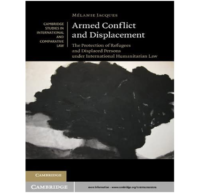Last Updated on July 29, 2022 by themigrationnews

(Cambridge University Press ISBN 978-1-107-00597-6, 277 pages)
The book ‘Armed Conflict and Displacement: The Protection of Refugees and Displaced Persons Under International Humanitarian Law’ explores the correlation between conflict and displacement by examining how the law of armed conflict – International Humanitarian Law (hereafter IHL) – deals with the issue of displacement. A series of questions are raised by the author in this regard—International humanitarian law prohibits forced displacement; however, does it protect civilians from all instances of forced displacement in armed conflict? And if it fails to do so, how does international humanitarian law protect persons caught up in armed conflict? Mélanie also asks whether the protection extended to the civilian victims of war is enough to tackle the global issue of displacement.
The theme of protection of internally displaced persons under international law has been studied extensively.[i]However, this study represents one of the most detailed accounts yet published concerning the treatment of refugees and other displaced persons under customary and IHL.This book provides a holistic study of the protection of ‘war migrants’ under international humanitarian law. Laying emphasis on ‘displacement’ as a common thread, the purpose of the book is twofold—firstly, it seeks to derive a comprehensive legal framework from the relevant provisions of international humanitarian law for the protection of displaced persons in armed conflict. Secondly, it not only aims to apply the issue of displacement within a broader context of civilian war victims but recognizes and addresses the drawbacks of international humanitarian law respectively.
Chapter one argues that as a fundamental principle of IHL, civilians enjoy general protection against dangers from military operations. IHL prohibits attacks that target combatants and civilians indiscriminately and lays down non-derogable obligations which bind all parties in an armed conflict. The most comprehensive of all is the prohibition of population transfers under belligerent occupation as it combines a ban on forcible transfers of civilians both from and within occupied territory and replacement with that of the occupying force’s own populace. In addition, IHL proscribes the forced movement of civilians in non-international armed conflict unless for the security of civilians or imperative military reasons. Despite all these provisions, there seems to be a legal gap in the existing protection regime as international law failed to regulate the forced displacement of civilians in the unoccupied territory during recent conflicts in the Middle East and North-West Africa.
In chapter two,Mélanie contends that rigid characterization of armed conflicts no longer reflects the reality of contemporary conflicts and is an impediment to the protection of civilians. In practice, the line between internal disturbances and internal armed conflict often gets distorted. Confusion is created by the different legal regimes, which are often abused by governments at the expense of the civilian population. This results in the difficulty for the actors’ parties to the conflict to determine the legal regime applicable.
The third chapter focuses on the practice of transferring population in occupied territory, frequently used by occupying forces to create facts ´etablis in occupied territory. Through the study of Israel’s settlement policy and the recent International Court of Justice Advisory Opinion on the legality of the construction of a Separation Wall in Occupied Palestinian Territory, this chapter explores the legal issues emerging from such practices.
Chapter four examines the concept of forced displacement as an international crime at length. The author first dives into the invaluable contribution to the development and clarification of the crimes of deportations and forcible transfers made by the jurisprudence of the International Criminal Tribunal for the former Yugoslavia (ICTY) and then proceeds to discuss the issue of population transfers as war crimes in internal armed conflicts. Concluding the chapter, Mélanieremarks that so far, there has been no prosecution for deportation or forcible transfer as a war crime despite the wide number of cases reported and implores that perpetrator of such unlawful practices should not escape punishment merely due to failure of establishing comprehensive and systematic conduct.
The fifth chapter endeavours to examine the protection offered to civilian refugees caught up in armed conflict. Preliminarily, the chapter deals with the necessity to explore the various applicability issues arising from the definition of ‘protected persons’ in relation to refugees. At the core, the chapter examines the protection offered by international humanitarian law to refugees in international armed conflict, with specific reference to the plight of ‘enemy’ refugees on the territory of a party to a conflict and the predicament of citizens of the occupied territory. Further, the author examines the principle of non-refoulment in international humanitarian law and its relation to the other branches of international law.
Chapter six focuses on the various issues of international humanitarian law with a particular interest in provisions for internally displaced persons in armed conflict, such as dispersion and reunification of families, humanitarian assistance, which are generally covered by international human rights law, as well as the rules of international humanitarian law. In the last chapter, emphasis is laid on the rules of international humanitarian law regulating the conduct of hostilities to reinforce the prohibition of armed attacks on refugee and IDP camps, specifically through the formation of protected zones immune from attacks.
This book provides a comprehensive study of the protection of refugees and displaced persons under international humanitarian law by underlining the imperative need to ensure respect and compliance with existing rules of IHL. It also unfolds the inherent issues existing in the very nature of IHL and emphasizes the need to bring about reforms. It further demonstrates the importance of relevant legal regimes complementary to the protection of refugees and IDPs in armed conflict.
Furthermore, it is suggested that the possibility of a non-binding instrument created on the model of the Guiding Principles on Internal Displacement is worth considering. Not only would it reaffirm the existing principles of humanitarian law applicable in a more comprehensive and systematic manner but also fill certain legal gaps subsisting in the protection afforded to displaced persons in armed conflict. Besides, such an instrument would act as a guiding tool for non-state actors engaging in the protection and respect for the rights of refugees and other displaced persons.
The book provides a clear and concise overview of the lex lata in this critical field. However, the study is undermined due to the lack of a cohesive argumentative or theoretical perspective which makes it difficult for a thorough read. Students and practitioners looking for an overview of disjunct topics will find informative and engaging discussions in the various chapters. Overall, there is a disconnection between the legal provisions and ideas – the author could have done more to smoothen the transition and clarify some of the correlations and tensions between different legal provisions. Despite its shortcomings, the book adds value and contributes to the field by substantially compiling, explaining, and methodizing scholarly, legislative, and judicial materials. Not only would it serve as an important foundation for future research but will also be of practical use both to academicians and practitioners working in the field, and policymakers aiming to further explore and transform this crucial branch of international law.
[1]Romola Adeola, The Internally Displaced Person in International Law (Edward Elgar Publishing, Cheltenham 2020) v + 208 pp, https://doi.org/10.4337/9781788975452.

Melody Khuoltaikim Singson is a law student from Campus Law Centre, Faculty of Law, University of Delhi who often delves into research, content writing and editing with a profound interest in international law, refugee law, human rights law, and peace, conflict & security studies and intends to pursue a Masters of Law degree in the same to further her knowledge and contribute meaningfully to what she considers her purpose.
